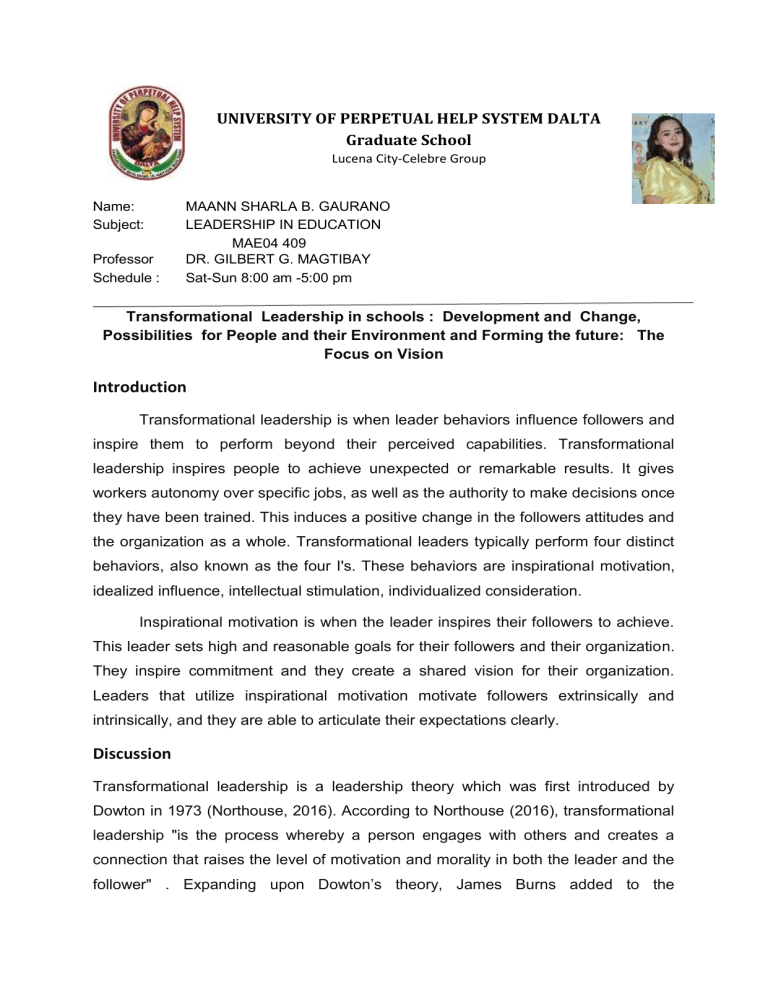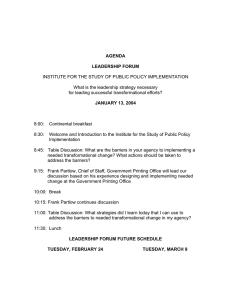
UNIVERSITY OF PERPETUAL HELP SYSTEM DALTA Graduate School Lucena City-Celebre Group Name: Subject: Professor Schedule : MAANN SHARLA B. GAURANO LEADERSHIP IN EDUCATION MAE04 409 DR. GILBERT G. MAGTIBAY Sat-Sun 8:00 am -5:00 pm Transformational Leadership in schools : Development and Change, Possibilities for People and their Environment and Forming the future: The Focus on Vision Introduction Transformational leadership is when leader behaviors influence followers and inspire them to perform beyond their perceived capabilities. Transformational leadership inspires people to achieve unexpected or remarkable results. It gives workers autonomy over specific jobs, as well as the authority to make decisions once they have been trained. This induces a positive change in the followers attitudes and the organization as a whole. Transformational leaders typically perform four distinct behaviors, also known as the four I's. These behaviors are inspirational motivation, idealized influence, intellectual stimulation, individualized consideration. Inspirational motivation is when the leader inspires their followers to achieve. This leader sets high and reasonable goals for their followers and their organization. They inspire commitment and they create a shared vision for their organization. Leaders that utilize inspirational motivation motivate followers extrinsically and intrinsically, and they are able to articulate their expectations clearly. Discussion Transformational leadership is a leadership theory which was first introduced by Dowton in 1973 (Northouse, 2016). According to Northouse (2016), transformational leadership "is the process whereby a person engages with others and creates a connection that raises the level of motivation and morality in both the leader and the follower" . Expanding upon Dowton’s theory, James Burns added to the transformational leadership theory by proposing that leaders are successful because they are good at recruiting good employees and recognizing skills and talents in each employee and using that to help the organization reach its goals (Northouse, 2016). Burns argued that transformational leaders are attentive to their teams’ needs and their motivations and that helping employees reach their full potential is beneficial to not only the employee and the leader, but the organization (Northouse, 2016) It’s important for a leader to recognize that each employee is different and that they bring a different skill set. When leaders recognize that they can transform their team using emotions, ethics, goals, and values, they can, in fact, begin to create a strong team (Denhardt, Denhardt & Aristigueta, 2016). The transformational leadership theory focuses on treating employees as human beings rather than just numbers. The theory requires that the leader be charismatic and able to see success in the future and how to obtain it. According to Burns, to be a transformational leader, the individual must be charismatic (Northouse, 2016). Here, trait theory and transformational leadership theory intersect. Charismatic leaders exhibit many of the traits that are positively related to leadership which are mentioned in the trait theory. Weber (1947) defines charisma as, “…a special personality characteristic that gives a person superhuman or exceptional powers and is reserved for a few, is of divine origin and results in the person being treated as a leader,” (Northouse, 2016, p. 164). Weber argued that being charismatic as a leader is just as important as being validated as charismatic by employees. A transformational leader is someone who can take viewers, can often bring significant changes to their opinions regardless of the background of the audience and on their specific issues. This is one of transformational leadership characteristics. A leader needs cooperation because one day, they will no longer be with the organization. To innovate creativity, they need to rely on creativity to take action, and to work hard without any guidance from autonomy. Showing creativity is one of transformational leadership characteristics. With the skill of leadership of leadership that inspires creativity and autonomy, they have these qualities. They understand the crew of leadership team development: There is no power to think for themselves and to do everything through the book. They know that a business or an educational institution, they are taught to be leaders of tomorrow. Through this collective knowledge, they can show the importance of others to dominate autonomous rules, so that they can use their creativity to break those rules like artists. Transformational leadership begins with a vision and a willingness to empower followers and provide the moral and material support needed to ensure that followers are able to execute tasks to bring about that vision. Such leadership nurtures a group identity that subordinates individual self-interest to the greater whole. It builds trust, creates a model for others to emulate, vigorously pursues the development of an organization’s human capital and instills a value system. Leaders that believe in and stand behind their moral values tend to influence others. By creating this vision, shaping a common identity, instilling a culture and a value system and responding to the needs of the workforce, a transformational leader can thus generate dramatic change and accomplish goals in which the organization was previously incapable of doing. Increased profitability is one of the outcomes of development. It also fosters innovation giving rise to increased profitability. It is not just about increased efficiency. Doing those activities effectively is equally important as well. Change can either be internal or external. It supports the active engagement of employees and other stakeholders. This aspect makes it possible for the stakeholders to be wary of forthcoming changes and understand the importance of those changes. Thus, the stakeholders become prepared for what to do when the changes take place. Learning Insights The evolution of transformational leadership in the digital age is tied to the development of organizational leadership in an academic setting. As organizations move from position-based responsibilities to task-based responsibilities, transformational leadership is redefined to continue to develop individual commitment to organizational goals by aligning these goals with the interests of their leadership community. The academic community is a front-runner in this sense of redefining transformational leadership to suit these changes in job definition. References: Bass, B.M. (1999). Two decades of research and development in transformational leadership. European Journal of Work and Organizational Psychology, 8(1), 9-32. Bass, B.M. (1995). The ethics of transformational leadership. In J. Ciulla (Ed.), Ethics: The heart of leadership (pp. 169-192). Westport, CT: Praeger. Denhardt, R., Denhardt, J., & Aristigueta, M. (2016). Managing human behavior in public and nonprofit organizations (4th ed). Thousand Oaks, CA: SAGE Publications. House, R.J., (1976). A 1976 theory of charismatic leadership. In Northouse, P. G. (2016). Leadership theory and practice (7th ed.). SAGE Publications, Inc. Northouse, P. G. (2016). Leadership theory and practice (7th ed.). SAGE Publications, Inc. Pirouz, A. (2015). What it takes to be a great leader. Huffington Post. Retrieved from https://www.huffingtonpost.com/alex-pirouz/what-it-takes-to-be-a-gre_b_7523662.html Sayyadi, M. (n.d.) Analyzing leadership and knowledge management in large companies. Retrieved from https://richtopia.com/effective-leadership/how-transformational-leadership-worksimportant https://www.careercliff.com/transformational-leadership-characteristics/



